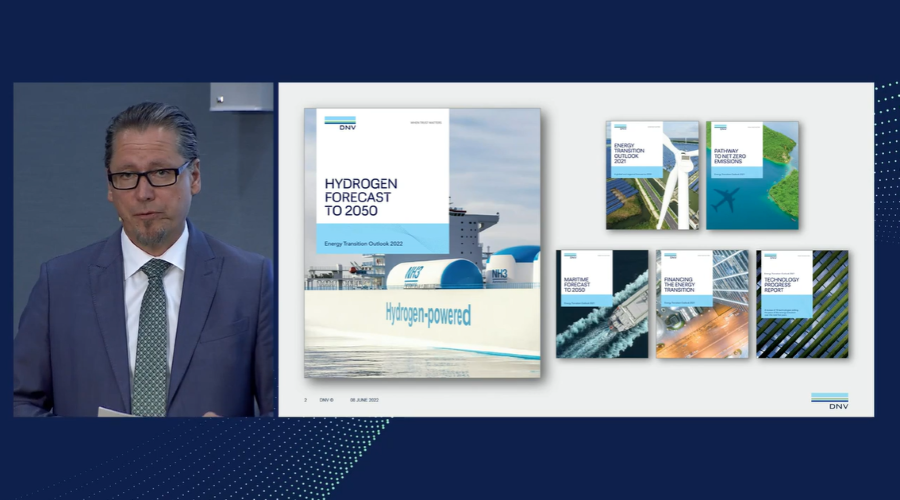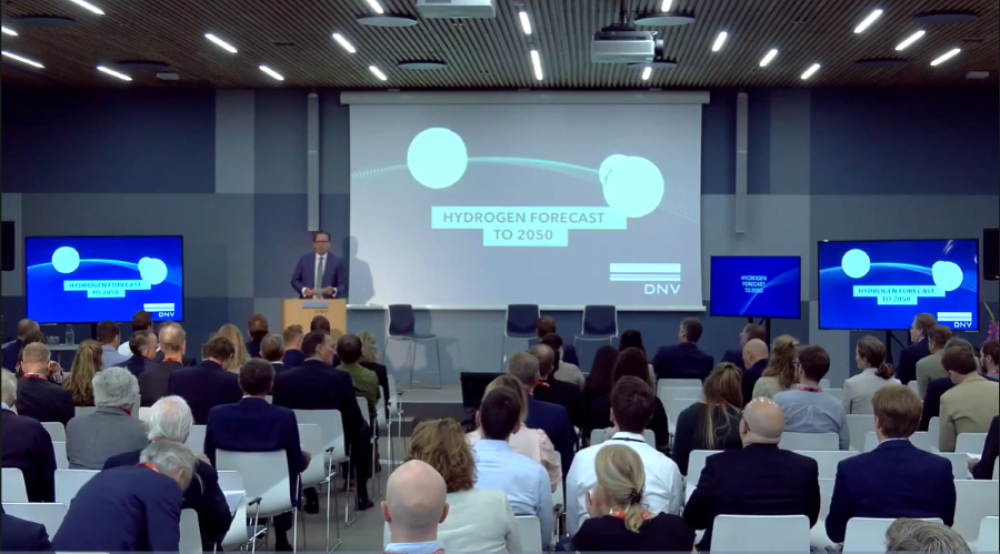Giving hydrogen a larger role in the global energy mix is critical to reaching goals set by the Paris Agreement but doesn’t come without its share of risks, experts in DNV’s Hydrogen Forecast to 2050 webinar said on June 14.
“Hydrogen seems to be everywhere and nowhere,” DNV group president and CEO Remi Eriksen said in the webinar. “A lot of people are talking about the big role hydrogen can take in the energy transition, but the amount of low-carbon, renewable hydrogen produced today is very, very small.”
According to DNV’s report, hydrogen should comprise 15% of the global energy mix by 2050 but is currently projected to make up only 5%. Eriksen also noted that in terms of delegating clean energy sources, hydrogen should only be used for hard-to-abate sectors such as aviation, maritime and high-heat manufacturing.
“Because hydrogen is so crucial for decarbonization for the hard-to-abate sectors, we cannot allow safety to become its Achilles heel.”—Remi Eriksen, Group President and CEO, DNV
“Throughout our forecast period and beyond, hydrogen will remain more costly and less efficient than direct electrification,” he said. “It is a precious resource that must be applied wisely and only for [sectors] that cannot be electrified.”
Ulrik Olbjørn, project manager for low carbon solutions at Equinor, echoed these financial concerns later in the webinar, imploring governments to stop giving false hope to the industry by saying the energy transition would be cheap. “The transition will be quite costly,” he said.
Cost considerations are only one of several hurdles in the way of achieving the 15% goal, including consumer safety concerns, but DNV is remaining optimistic.
“We've moved already from negligible role for hydrogen to 5%, and I think to go from nothing to 5% to 15%, I think it's almost easier to scale 5% to 15% than it is to go from 0% to 5%,” Hari Vamadevan, U.K. vice president at DNV, told Hart Energy.

Safety’s important role
To develop a hydrogen ecosystem, governments and corporations must work together to gain the trust of the consumer, develop infrastructure for hydrogen delivery, create a scale of hydrogen production and implement government incentives to develop the hydrogen value chains.
Due to its higher flammability, consumers are much more hesitant of increasing the amount of hydrogen in the global energy mix than they are of using LNG and other natural gas products. DNV is working to paint a more positive picture of hydrogen and its helpful qualities through its research facility in northern England.
“There’s going to be a series of mini transitions.”—Hari Vamadevan, Regional Director, U.K. and Ireland, Energy Systems, DNV
“Because hydrogen is so crucial for decarbonization for the hard-to-abate sectors, we cannot allow safety to become its Achilles heel,” Eriksen said. “Hydrogen shares many properties with natural gas, but it does have some unique properties likes its higher explosion reactivity.”
At its Spadeadam, U.K.-based research and testing facility, the company is working to improve safety conditions for hydrogen transport through “extensive physical testing,” through which researchers have determined where to concentrate hydrogen efforts.
In addition to the testing facility, DNV also built Hy Street, a row of houses in which the U.K. government experiments with the use of hydrogen as a replacement for residential and commercial natural gas-run appliances.
“Methane is 5% to 15% [flammable]; hydrogen is 4% to 75%. So making hydrogen safe is completely possible, and it's something that DNV is playing a big part in,” Vamadevan said. “Developing that safety case for hydrogen is an important part of the overall development of the energy ecosystem and in the U.K.”
Group effort
According to the Hydrogen Forecast report, it’s predicted that $129 billion U.S. dollars (USD) globally will go to investing in hydrogen by 2030 and $440 billion by 2050, with even more to come in the second half of the century. This is a substantial increase from the $12 billion invested in hydrogen last year.
As 2050 draws closer, DNV analysts predict that the cost of producing green hydrogen will fall to a global average of $1.50/kg USD by 2050, eventually becoming cheaper than blue hydrogen and surpassing it in production.

Although the world is predicted to favor green hydrogen as it becomes more economically sustainable, that doesn’t render blue hydrogen obsolete as the energy transition transpires. Rather than serve as a short-term solution, blue hydrogen will remain important at least through the forecasted period.
“There’s going to be a series of mini transitions, and that’s the best way to look at the energy transition and to look at hydrogen,” Vamadevan said. “It’s not something versus something else, it’s actually all of these things happening. It’s just a question of timing.”
In order to raise the necessary capital to make green hydrogen more accessible, stronger governance is required through enabling policies and creating direct subsidies, Eriksen said.
However, all facets of the industry, from national governance to consumers, are required to work in tandem to achieve these goals. The responsibility of growing hydrogen’s presence in the global energy mix can’t fall solely to governing bodies, Vamadevan said.
“There is no net zero without hydrogen, and therefore if the governments provide the framework, I think industry can step up, and that's really the key,” he continued. “It's that partnership between government and business, and then let's not forget to take the consumer on along the ride with us.”
Recommended Reading
Some Payne, But Mostly Gain for H&P in Q4 2023
2024-01-31 - Helmerich & Payne’s revenue grew internationally and in North America but declined in the Gulf of Mexico compared to the previous quarter.
Kimmeridge Fast Forwards on SilverBow with Takeover Bid
2024-03-13 - Investment firm Kimmeridge Energy Management, which first asked for additional SilverBow Resources board seats, has followed up with a buyout offer. A deal would make a nearly 1 Bcfe/d Eagle Ford pureplay.
M4E Lithium Closes Funding for Brazilian Lithium Exploration
2024-03-15 - M4E’s financing package includes an equity investment, a royalty purchase and an option for a strategic offtake agreement.
Laredo Oil Subsidiary, Erehwon Enter Into Drilling Agreement with Texakoma
2024-03-14 - The agreement with Lustre Oil and Erehwon Oil & Gas would allow Texakoma to participate in the development of 7,375 net acres of mineral rights in Valley County, Montana.
California Resources Corp. Nominates Christian Kendall to Board of Directors
2024-03-21 - California Resources Corp. has nominated Christian Kendall, former president and CEO of Denbury, to serve on its board.





